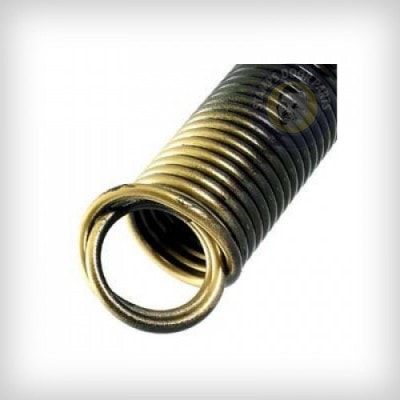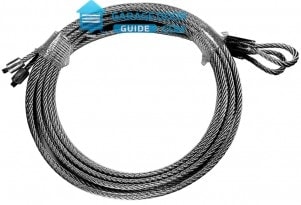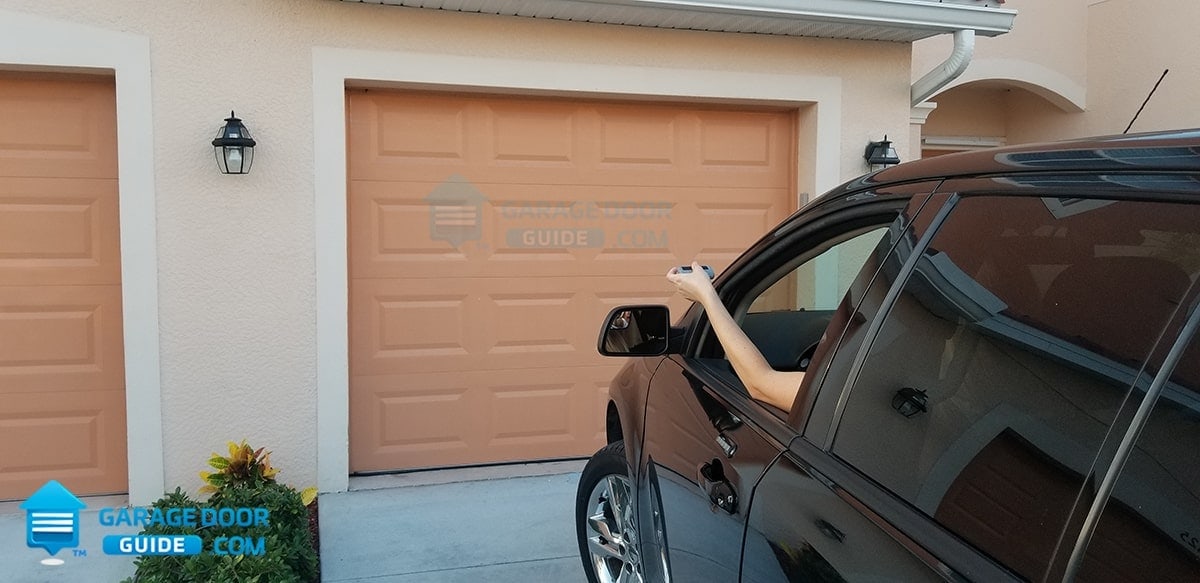Garage Doors That Won’t Open: 15 Reasons You Can’t Get It Up
The most common reasons a garage door won’t open include broken springs, stripped opener gears, snapped cables and remote signal malfunction. Overhead doors that are stuck closed are usually the result of broken parts.
Having a door stuck shut can be one of the most frustrating situations a homeowner can encounter – especially when your vehicle is trapped in the garage and you are trying to go somewhere. Many people use the garage door as the main entrance to their home further adding to the problem.
I created this troubleshooting guide to help you figure out why your door isn’t opening. Here are 20 possible explanations for your door being stuck closed.
Why is my garage door so heavy to lift?
How do you open a garage door with a broken spring?
Can you open a garage door without power from the outside?
Why is my garage door so heavy to lift?
A properly balanced and adjusted torsion spring will counterbalance about 90% of the weight of your garage door. That means a typical double car garage door weighing 200 lbs will only require 20 lbs of force to move. I recently tested my single car door to see just how much weight your opener lifts when the door is balanced properly. I discovered that openers can lift hundreds of pounds, but they are designed to lift a little weight over a long period of time.
All garage doors are heavy due to the size and construction materials used. Overhead doors have to be strong enough to resist external forces (weather) and the wear of frequent use. Most garage doors are made out of steel, but some older doors could be made out of solid wood – a much heavier material. Normally the construction material isn’t much of a problem since the springs do most of the heavy lifting.
This counterbalancing effect makes it possible for your automatic opener to lift the door over the long term without wearing out quickly. If your door is extremely heavy to lift by hand or if your opener seems to be struggling there is a good chance one of your springs are broken or the springs were never calibrated and adjust correctly in the first place.
How do you open a garage door with a broken spring?
If your are trying to open a garage door with a broken spring you are in for some heavy lifting. Using your automatic opener with a broken spring can damage internal components (nylon drive gear) in your opener or damage the top section of your garage door. – so use the opener only for emergencies.
1. First, you will need to disconnect the opener (if one is installed) by pulling on the red emergency release cord – disengaging the opener trolley. An alternative is disconnecting the J-Arm by removing the cotter pin in the attachment bracket on your top section.
2. Next, you will need to use a pry bar to get some space between the bottom of the ground and the floor so you can get some space for your hands to lift – inserting a piece of wood or block for the door to rest on so your fingers won’t get smashed.
3. Now comes the hard part – lifting the full dead weight of your garage door. This is best done in a team of 2-3 people for double doors. Getting the door started up (first 2-3 ft) will be the hardest part. Once the top sections of the door start curving around the curved track radius it gets much easier.
After getting the door completely open you will need to ensure that the door doesn’t slam back down to the ground. You will need a few sets of vice grips to clamp on each side of the vertical track under the rollers.
Can you open a garage door without power from the outside?
Your best options for gaining access to the garage in the event of a power outage would be through an exterior man door or window. If the power goes out with the garage door in the closed position you can’t open the door unless you have access to the manual red release cord.
You could consider busting out a glass window if you have lights in the top section of the garage door. Otherwise you could attempt to fish a coat hanger wire between the top section of your door and the weather seal. Usually there is enough of a gap to feed a wire hanger through to catch the opener release cord and disengage the trolley.
The last and most expensive option involves cutting a hole into the bottom section of your overhead door and then replacing it after gaining access. Most people people don’t have an emergency key release lock (G1702LM) installed, but in situations where you are locked out it can save you a lot of time and money.
1. Broken Torsion Spring

Garage door springs are rated at an industry standard 10,000 cycles and most doors get used 3-4 times daily. Assuming your springs were installed and calibrated correctly you can reasonably expect them to last and average of 7 years.
Torsion springs load up on tension using the force of gravity as the door shuts. Couple that with the fact that garage doors also spend the majority of idle time in the closed position. These two factors explain why torsion springs almost always break with the door closed.
The good news is that it’s much safer if springs break with the door closed since it won’t be at risk of slamming down to the floor. The bad news is that you will have to lift the full dead weight of the door to open it. This can be mitigated if you have a two spring solution verses only a single torsion spring. If one spring breaks the other spring can assist in lifting until repairs can be made. Unfortunately, this isn’t popular because its significantly more expensive.
2. Broken Extension Spring

Extension or “stretch” springs are the second most popular garage door counterbalancing option. Unlike torsion springs that load up under tension by winding on a fixed shaft, extension springs stretch out with a cable pulley system. Two or four springs are mandatory in an extension spring system because each spring has pull equally on both sides of the door.
When one of the extension springs breaks the door will be partially stuck since the door is in an unbalanced state. Attempting to raise the door up will result in the door stair stepping from side to side in the tracks.
Attempting to open your garage door with any type of a broken spring puts excessive stress on both the top panel of your door and the main nylon drive gear inside your opener. For these reasons its not recommended to do so outside of emergencies.
3. Stripped Nylon Drive Gear

Several components inside the casing of residential openers are made of nylon. When the opener is over-stressed the teeth on the drive gear can strip out and fail. You might be wondering – “Why not just build all the parts out of steel?”
Nylon drive gears are made to fail to protect your (more expensive) door sections from being damaged.
Some nylon drive gears simply wear out due to old age or from overheating – excessive use without lubrication. In any case, a stripped gear will prevent your opener from lifting the door up off the ground.
4. Door Frozen To The Ground
Do you live in a cold climate? If so, freezing temperatures are a real concern for safe garage door operation. Snow and ice regularly build up in front of overhead doors in winter causing the door to freeze to the ground.
Even if you clear the opening and apply a de-icing agent cold temperatures are a huge problem. Moisture can drip down the face of door into the section joints and freeze. As you attempt to open the door the tongue and groove joints are fixed in place.
De-icing agents like rock salt aren’t the best solution either. They can be corrosive, eating away at the bottom of your door. Other components like cables, hinges and rollers can be affected too. Keeping snow, ice and other debris free and clear from opening is crucial during the cold winter season.
5. Reprogram Remotes And Keypads
Occasionally garage door openers can fall out of sync with your remotes and transmitters. While this can be a sign of circuit board issues, it can also happen for no reason at all. Power surges caused by near-bye lightning strikes have been known to clear out data in the opener.
Another common issue is someone inadvertently holding down the program or learn button on the back of the unit. A small square button about the size of a penny controls the programming mode for your opener. If the button is held down for several seconds all of the devices connected to your opener will be erased. In order to re-program your devices you will need access to both the learn button and each device you into to sync to your unit.
6. Bad Opener Circuit (Logic) Board

The brains of your opener are contained in the casing of your logic board. This circuit board directs all of the critical functions of your opener like an on board computer. Logic boards go bad for a variety of reasons including old age.
The most common reason for a bad board is a near bye lightning strike. You might want to consider installing the Liftmaster 990LM surge protector to offload any possible electrical overload from near-bye storms. You might even consider an in-house solution to protect all of your appliances.
Logic boards contain a colored learn button that identifies the frequency and a code number (Ex. 41A5021-I) that corresponds to a specific opener model. Chamberlain Liftmaster codes usually start with a “41A” prefix and have learn button colors that are (Yellow, Purple, Red, Green or Orange).
7. Remote Signal Interference
If you have to get right up to the garage door to open your door with the remote transmitter there is a good chance you are experiencing some type of radio frequency (RF) interference. Common household items like light bulbs, freezers and stereo equipment are known culprits of opener signal interference.
Luckily, there are some things you can do to fight back. I wrote an extensive articled called Top 5 Ways To Increase Garage Door Remote Signals that examines other sources of interference and steps you can take to boost your remote signal strength. Its definitely worth a read if you are sick of having to pull right up to the door to engage the opener.
Eliminating sources of RF interference, changing your antenna and upgrading your opener technology (MyQ) are a few of the ways to combat poor range.
8. Disengage Lock Button
Wall controls have a master lock out button that can be pressed to prevent all connected devices from operating the opener. Most people reserve use of the wall control lock button for times when they are going away on vacation or situations where a remote has been lost or stolen.
Sometimes lock buttons get pressed inadvertently or even by children playing with the controls. Newer model wall controls have much better placement of the lock out button, underneath the main plastic cover. That way there is less of a chance of the button being accidentally pressed. If your garage door won’t respond to your remote or keypad be sure to check the wall control.
8. Opener Trolley Disconnected
The red cord hanging down your opener is known as an “emergency release cord” allowing you to disengage the opener. In the event of a power outage or broken opener component you can disengage the opener from the door to operate it by hand – pulling it open and pushing it down to close.
If someone with access to the garage has pulled this cord your opener won’t work when you hit your remote control. The trolley will cycle up and down until it re-engages with the assembly. If someone has pulled too hard on the emergency release cord it can get stuck in the open position, causing it to not automatically re-connect itself. You will have to pull on the red cord even further until it pops back into place.
10. Power Source Disruption
If you plug in too many devices at the same time it can trip the circuit breaker. This is common in situations where refrigerators and deep freezers are installed. They can cycle on at the wrong time causing an overloaded circuit.
Make sure your opener and photo eyes are plugged in. You should be able to see both the light bulb and small glow lights on the back of the unit. If you continue having issues you might consider hiring an electrician to examine the problem. They can test the current running to various devices in your garage using a multimeter.
If you know for sure that you have a power outage then your opener won’t work unless you have a Liftmaster 485LM batter backup installed. This technology is available on newer models, allowing you to operate the garage door 20 times without power. The alternative is entering the garage through and mandoor and opening your door lifting by hand.
11. Lock Manually Engaged
Accidentally using your garage door opener with a slide lock or keyed lock engaged is a recipe for disaster. This is especially problematic on older machines that lack the excessive force shutoff monitor.
Running your opener with a lock engaged can strip out the nylon drive gear and tear up the top section of your door. You won’t be able to manually lift a door with an interior lock engaged either. The door will have to be unlocked with a key or by entering the garage door through a side entry door to slide the latch out of the track.
12. Dead Batteries
Remote transmitter and wireless keypad batteries should be replaced at least every 5 years – if not sooner. Using a device with a weak battery can reduce the signal, especially during the cold months of winter.
Always check for corrosion inside the casing of your remote or keypad. Then check to make sure the contacts that touch the positive and negative terminals are aligned correctly with the battery.
13. Bent Or Obstructed Track
Tracks that are bent from being hit by a vehicle are a ticking time bomb for your overhead door system. Garage doors function best when the tracks are even, flush and level. This balance allows both cables to pull equally on each side of the door. Tracks that are bent are prone to door components like rollers pinching and catching.
Obstructed tracks are another common problem as most garages are used for storage. Common items like tools, garbage cans and shelves can obstruct the rollers from passing through the vertical track. On newer openers the excessive force monitor will trigger and prevent the opener from working. Older openers that lack this feature may continue attempting to pull up the door causing a stripped drive gear or damaged top center stile.
14. Cables Broken Off Drums

Cables are under an extreme amount of tension as part of the garage door counterbalancing system. The force of your springs (torsion or extension) is transferred through the cables to the bottom fixture. If your cables are broken or have slipped off the drums this lifting force is lost and you or your opener will have to lift the full dead weight of the door.
Even if your cables have only slipped on one side of the door you shouldn’t use your opener. The door will probably swing down crooked in the opening and stair-step side to side. The door should be clamped off until it can be reset by a repair technician.If you need to get in the garage you will probably need a few people to team up on the door to get it all the way open.
15. Rollers Out Of Tracks
Garage door rollers can fall out of the tracks causing the door to grind and catch during operation. This is especially true for the rollers on the bottom left and right sides of the door. If a roller slips out of the channel of the track the opener reverse system can be triggered.
Rollers can fall out of the tracks from the internal bearings going bad due to old age.They can also fall out when one of your garage door hinges or brackets comes loose. Most rollers have a 4″ long stem attached to the wheel – so tracks that have been set too wide or are bent can also cause the roller to fall out.
See anything we missed? Leave a comment below and let us know why your garage door is stuck closed.


